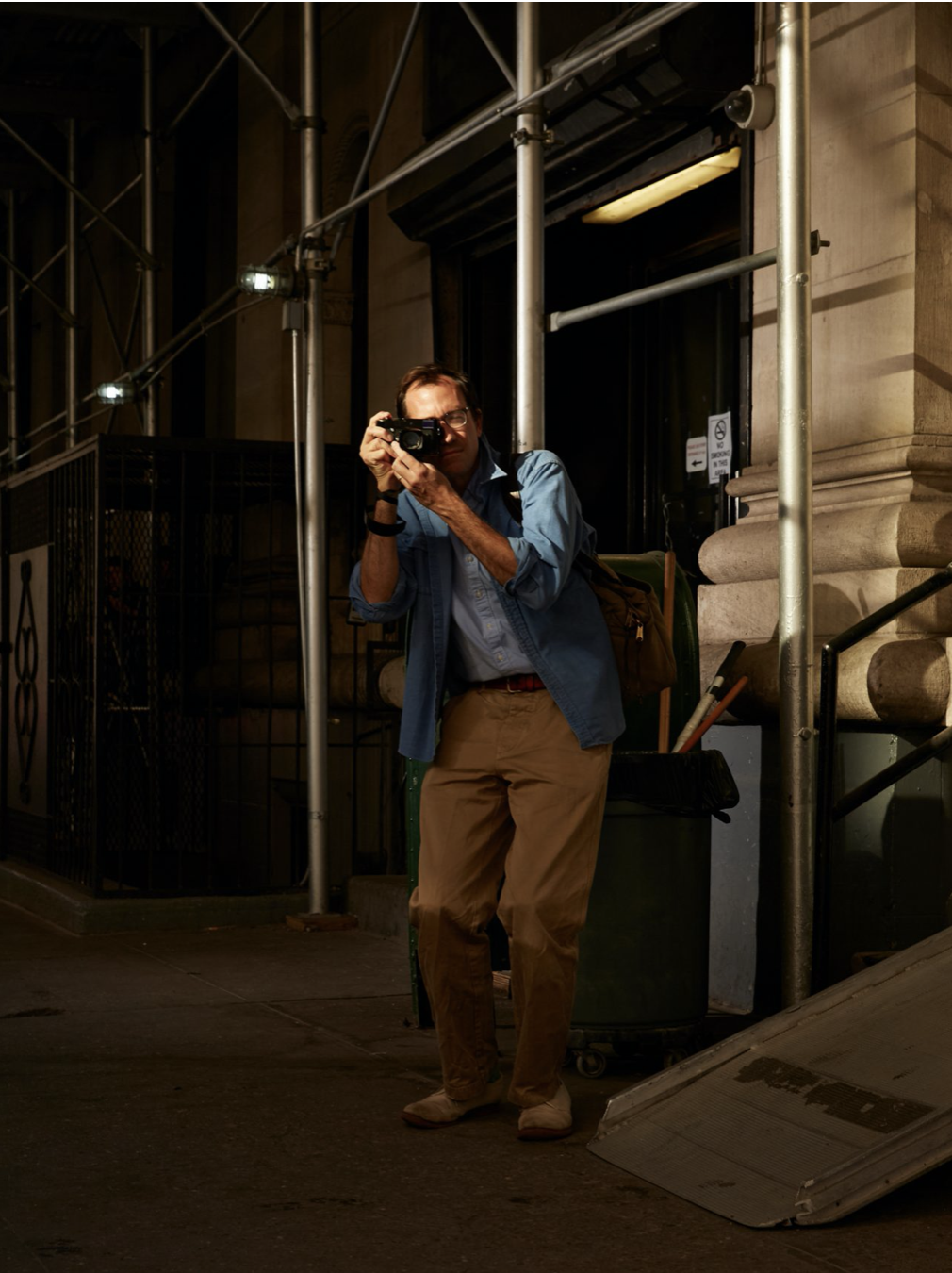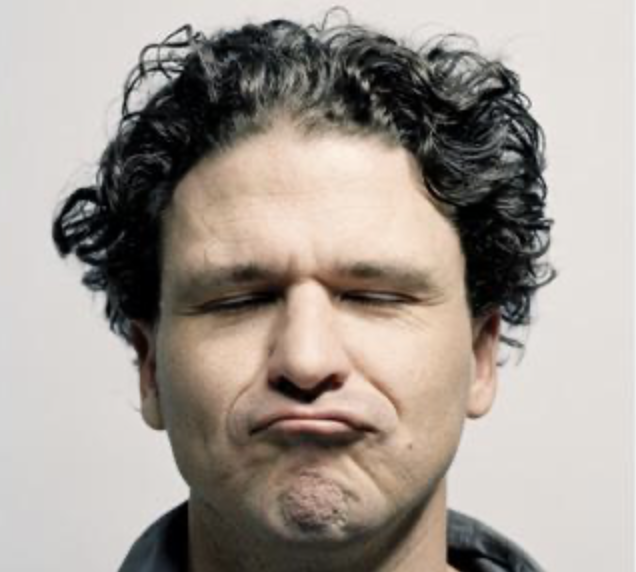INTERVIEW

The night before meeting painter Danny Fox in his studio, I stroll around his neighborhood in Downtown Los Angeles. As twilight sets in, the sky turns from light blue to pink to purple to dark blue with a bit of yellow. L.A. at its best. In stark contrast to this scenery on the city’s horizon: the hard colors of tents, torn pieces of canvas and a jumble of sleeping bags and shopping carts that stand out against the concrete high-rise directly behind. An improvised encampment that provides nightly shelter for people who cannot meet up with the demands of the city. Until quite recently, many homeless people here could find a provisional place to stay in one of many vacant office towers. All such spaces have now been transformed into luxurious hotel rooms, state-of-the-art offices and light-bathed artists’ studios.
When I arrive at the studio in the morning, the encampment is gone, dissolved in the day’s hustle and bustle. Fox’s studio is three floors above the busy street. A space of 300 square meters with large windows facing the street, high ceilings and twenty paintings leaning against a white wall. They are placed in a row, making for a cinematic experience when passing in front of them. A piccolo dressed in red sits on a yellow velvet chair, looking at us with resignation. He appears to have no intention of picking up those heavy suitcases, he is biding his time in the tropical night. Next is a girl in a dressing gown. Is she waiting for her lover? The balcony’s balustrade seems Parisian, but the view is of a pasture where a horse grazes in the moonlight. Then a man sitting at a bar, surrounded by antique decanters, a champagne glass in front of him, and two framed portraits with their gazes fixed on the nocturnal drinker. They are all people who seem familiar, in a world out of time. Mood and style bring the films of Wes Anderson to mind, while the landscape elements are reminiscent of Matisse or Gauguin.
It conjures something that I recognize, without having any memory of it. Travel without tourism. Hotel rooms without smoke detectors. Bars without glaringly-labeled bottles. Lovers furtively longing for each other, without intermittent iPhone updates. A romantic scene. By combining visual elements from different places and times Fox creates a new world.
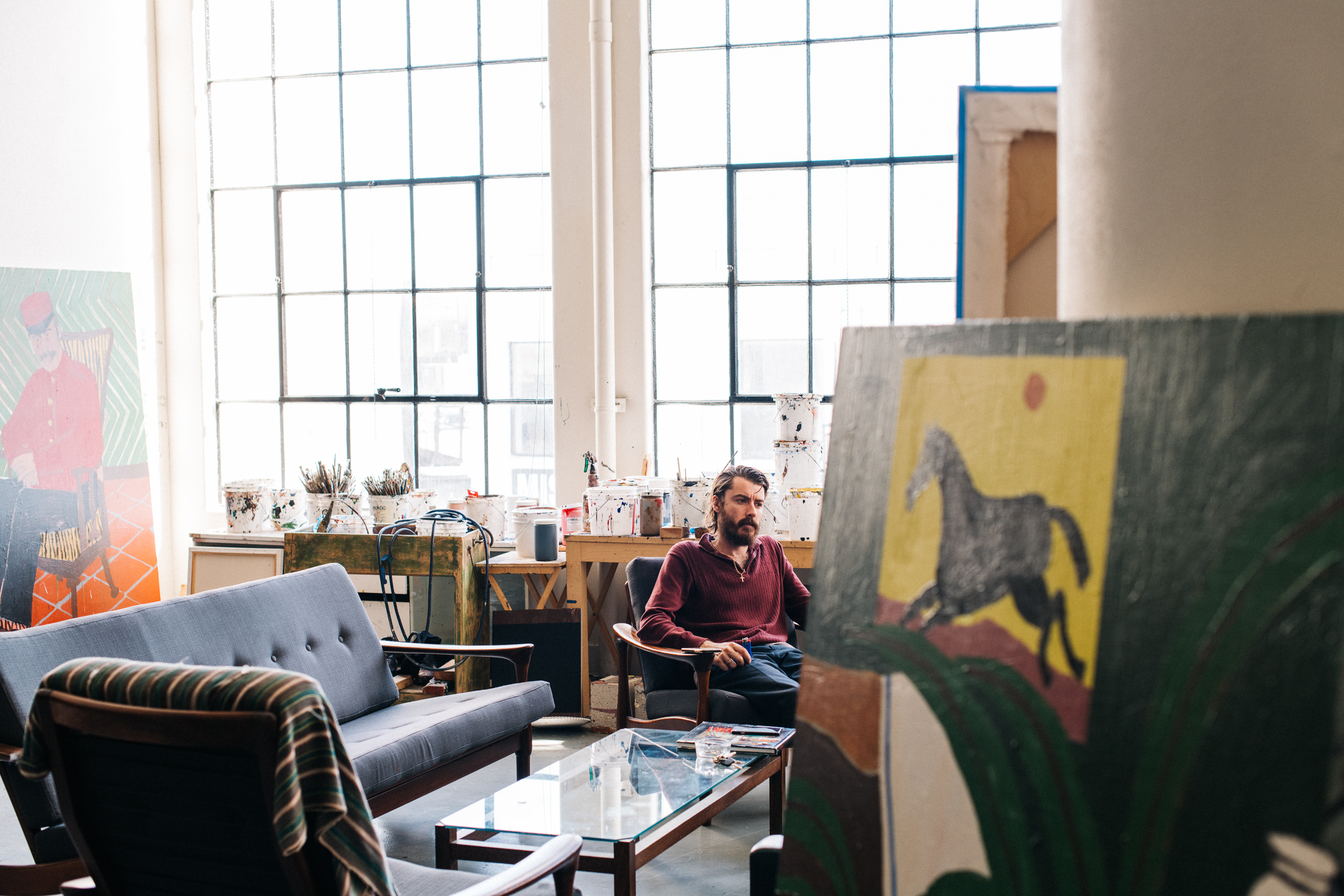
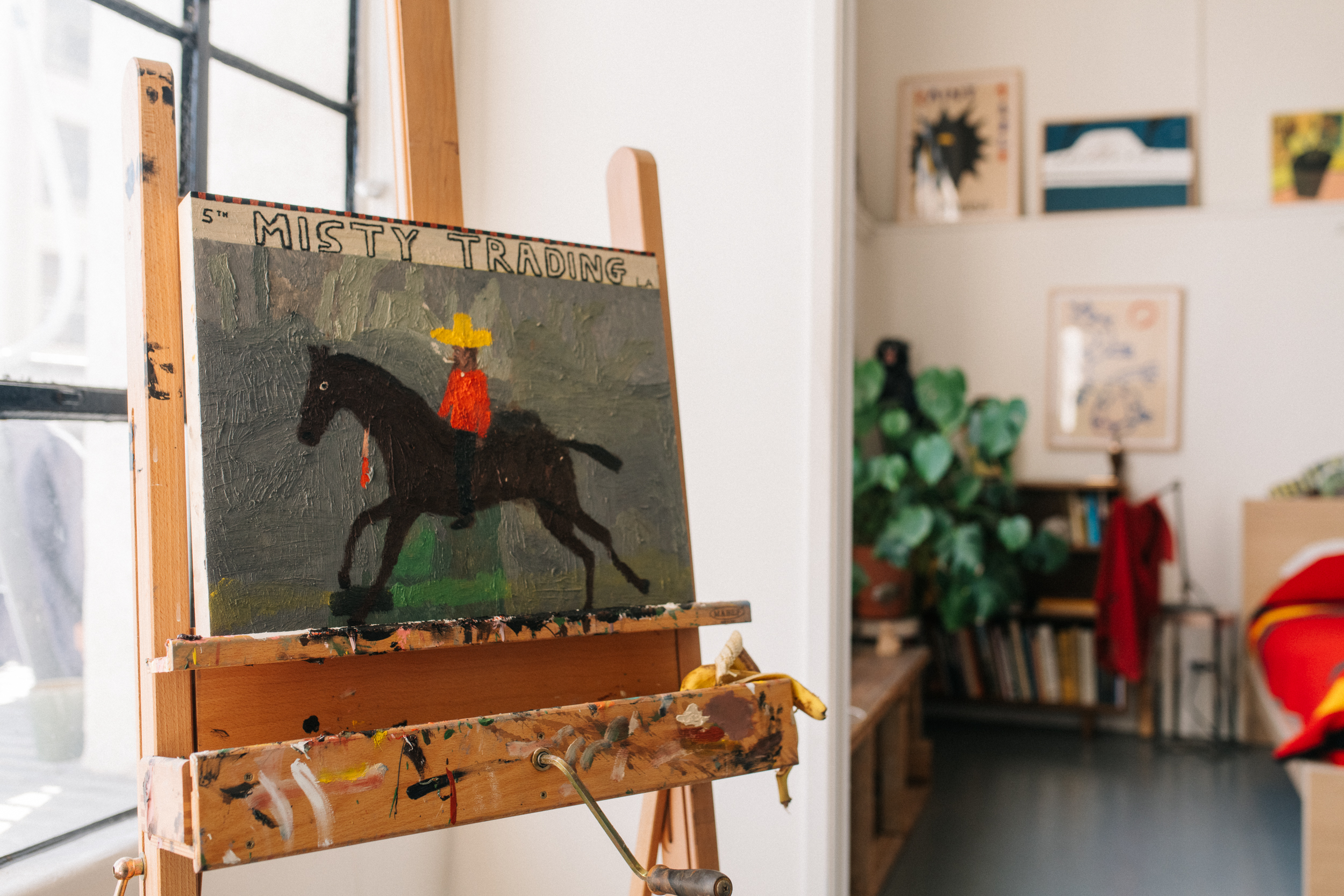
Danny Fox just finished an artist’s residence at The Figueroa Hotel, around the corner. The hotel invited him to stay for three months, as the first artist in their residence-program, to depict his experiences during his stay.
After two months however, The Figueroa Hotel decided to discontinue the project. They hadn’t taken into account that a painter has to paint. And that the bed-linen and carpet in a hotel room aren’t the best spots to spill it. Fox did make a series of paintings during his stay. Most of them represent not the experience he had, but his expectations of the experience before his actual stay at the hotel. He did make use of the room, slept there at night, and he made good use of the bar—free booze every night—but in the morning he went back to his studio to get to work, just like he always did. ‘In the end, you just long for your own place, your own stuff surrounding you.’
His own place for now is this studio, where he works and lives. A home far away from home. He was born across the Atlantic, in the former fishing village St. Ives. After WWII it had become the centre of a Modernist art movement. Following the decline of fishing and mining industries which had been the town’s economic backbone for ages, it became attractive to artists, who set up their studios in abandoned warehouses. On sunny days the sea is said to take on a purple hue and one could imagine oneself on the Italian coast. A place of which sculptor Barbara Hepworth said: ‘I, the sculptor, am the landscape.’
When Fox was ten years old, Tate Modern opened a gallery in St. Ives. There were workshops for kids. ‘I made monoprints there, or lithographs. Sophisticated techniques that kids don’t usually learn at that age. As soon as I started growing pubic hair, I lost interest in everything else. All I wanted to do was hanging around in the arcade, chase girls and drink cider.’ Art came back into his life at age fourteen, with the discovery that he could combine painting and his interest in women.
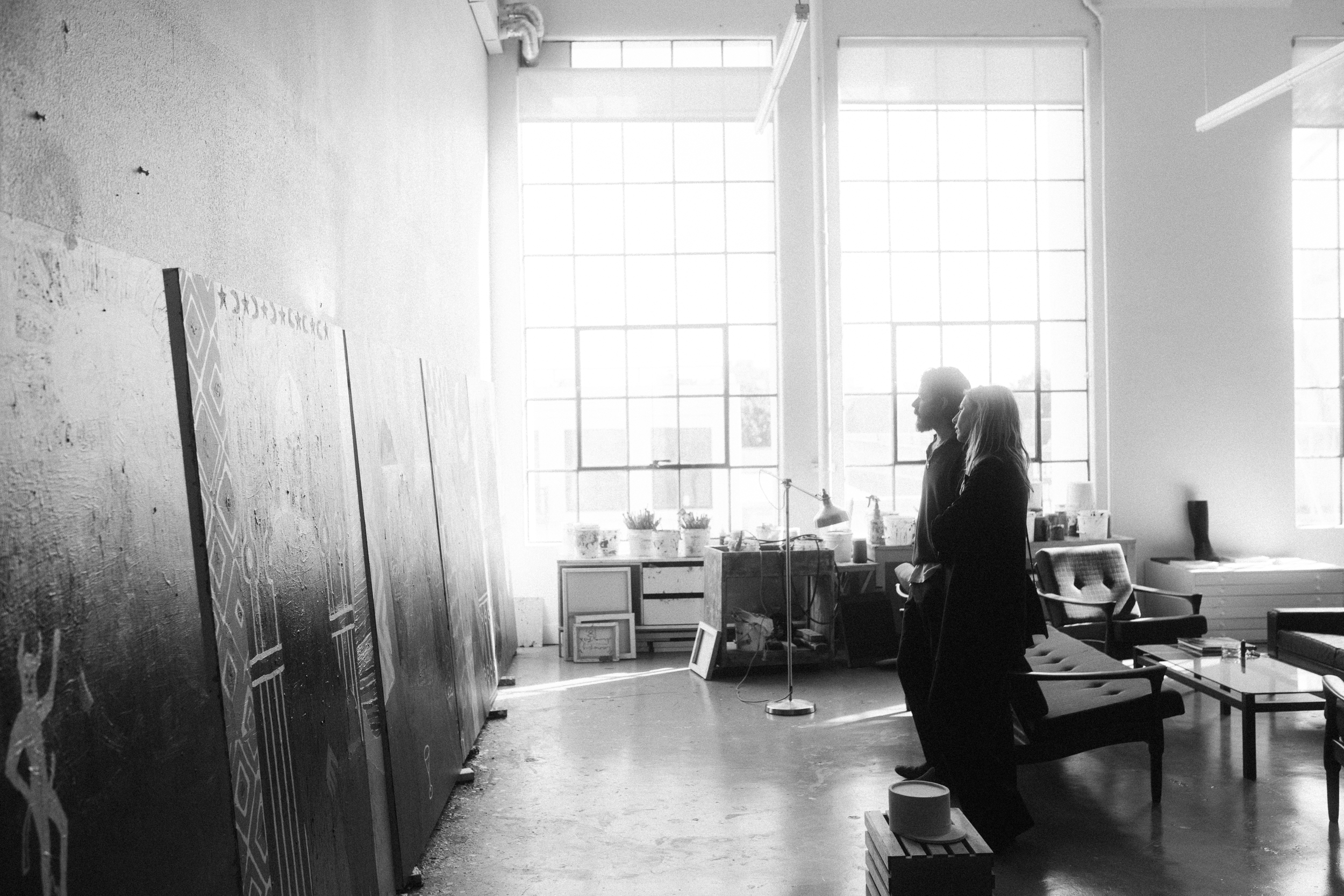
He was obsessed with women. The hormones that raged through his body found a way out onto paper. As a lucky circumstance he found he could impress women with his draughtman’s skills. At an age when most choose to enjoy their youth, Fox spent a lot of time on his own, painting.
At sixteen he knew what he wanted to do. Instead of going to art college, he went to the local library. In the small Arts section, he found exactly what he needed: Van Gogh, Matisse, Kahlo. ‘You need source material, I was quick to realize that. I wouldn’t find that at school or art college. I had to do my own thing. Youth was something outside of me, I didn’t take part in it. Painting was more a religious exercise than something I enjoyed.’
It took him fifteen years to produce a painting that matched his own standards. Fifteen years without money, various jobs at the same time and not much fun. ’Van Gogh only painted for about seven years of his life, but he hit a vein. In terms of creativity. The deeper they cut into their artery, the more intense their creative energy, and the quicker it burns away. Often resulting in an early death. That’s why I try to look at Picasso and Matisse. That’s my boys. I don’t wanna die, I wanna be a hundred years old.’
Having no desire to copy Van Gogh’s lifestyle, Fox was nonetheless inspired by his lines, his impasto style, the thick layers of paint on the canvas. Later still, he encountered the work of Outsider Artists, drawings in a naive style in which the artists seemed to forego all notions of artistic skill. But appearances deceive, Fox insists. ‘I could tell straight away if someone can draw or not. Even in abstract paintings. Take Pollock. It has to do with the confidence of the hand. When you look at a painting, you need to know that everything is in that place because the painter wanted it to be there.’
Fox sits on the couch, on a wall behind him a tormented version of himself looms. I ask how he begins on a self-portrait, does he use photo’s? Turning to look at the painting, he says: ‘No, I know what I look like. And that’s not really how I look. That was how I felt. I was going through divorce. In the painting my hair-line is further back.’ He points at another self-portrait, elsewhere in the studio. ‘There it’s even worse. I felt like time was pulling me back. You know. For men, that shows in the hair.’
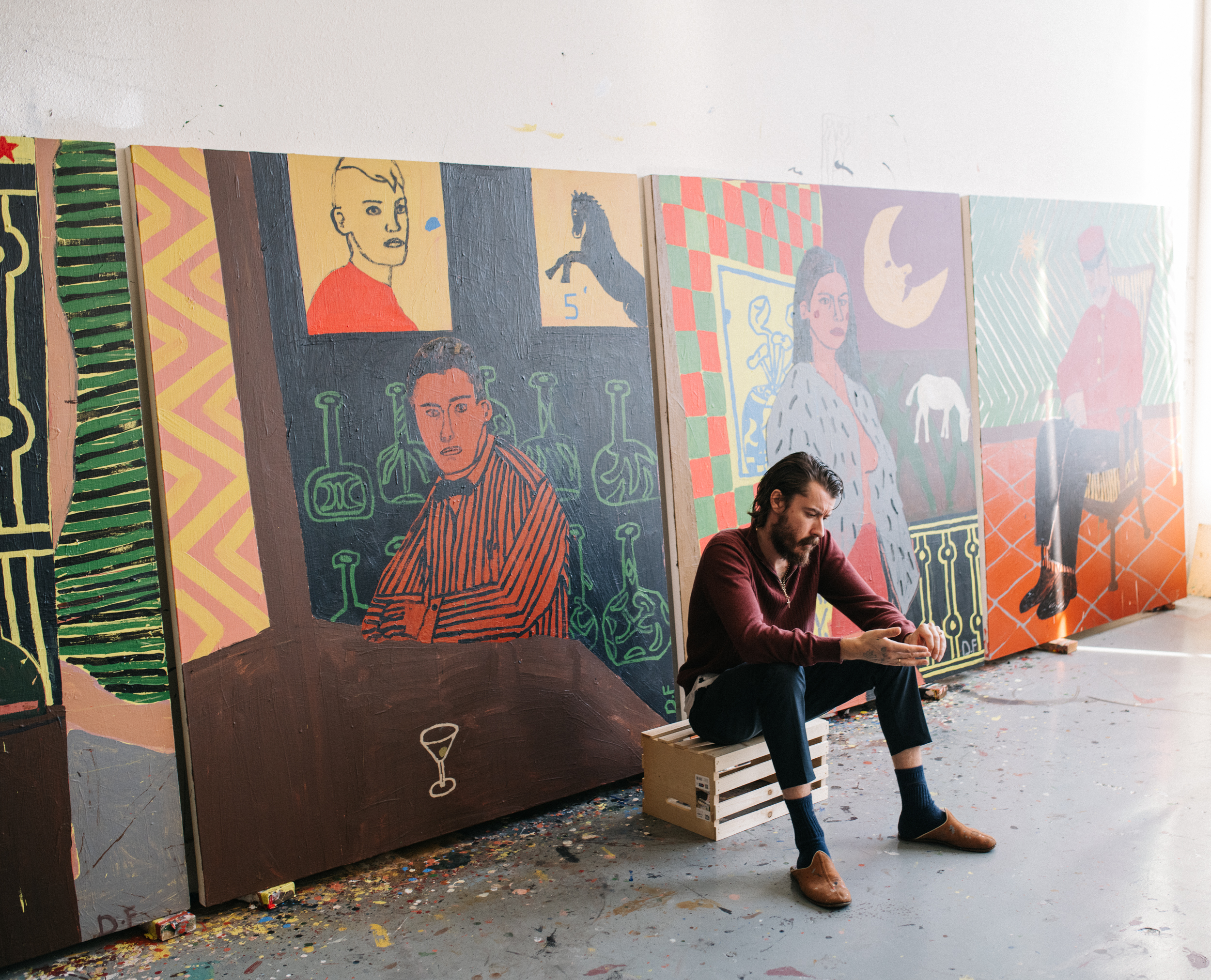
Karel Appel once said that painting is about an inner evolution. I ask Fox if that’s his aim as well.
‘It’s not a self-help tool. But a great painter is someone who is able to show you with an image, what’s happening inside of them. And you have to feel it’s a genuine representation of what’s inside of them. When you look at it, it moves you. But the painting is a funny thing you know, it has to look good. So yes, I guess painting should reflect your inner evolution, if there’s been any.’
Some of Fox’s paintings are based on photo’s, found on Instagram or elsewhere. He saw a picture of Tali Lennox (Annie Lennox’s daughter) and used it in one of his paintings. ‘It’s not something I usually do. But it’s a strong image, and once you paint it, the decision is made for you.’
His subjects take on shape as layers accumulate on the canvas. First the canvas is primed, then painted white. In the next layer he adds colour. ‘I usually wait until there’s somehow some emotion in the colour, and a rough abstract composition, then I start to think about content and subject matter.’
Sometimes he starts with sketches. He indicates the painting on which a man with a hat floats in the undefined space of the canvas, in the lower left-hand corner the smoldering remains of a burning house. It is the head of a pilgrim from an old engraving. ‘That asks for a sketch. Which then turns up very differently on the painting.’ He came across the pilgrim on his inquiry into divorce.
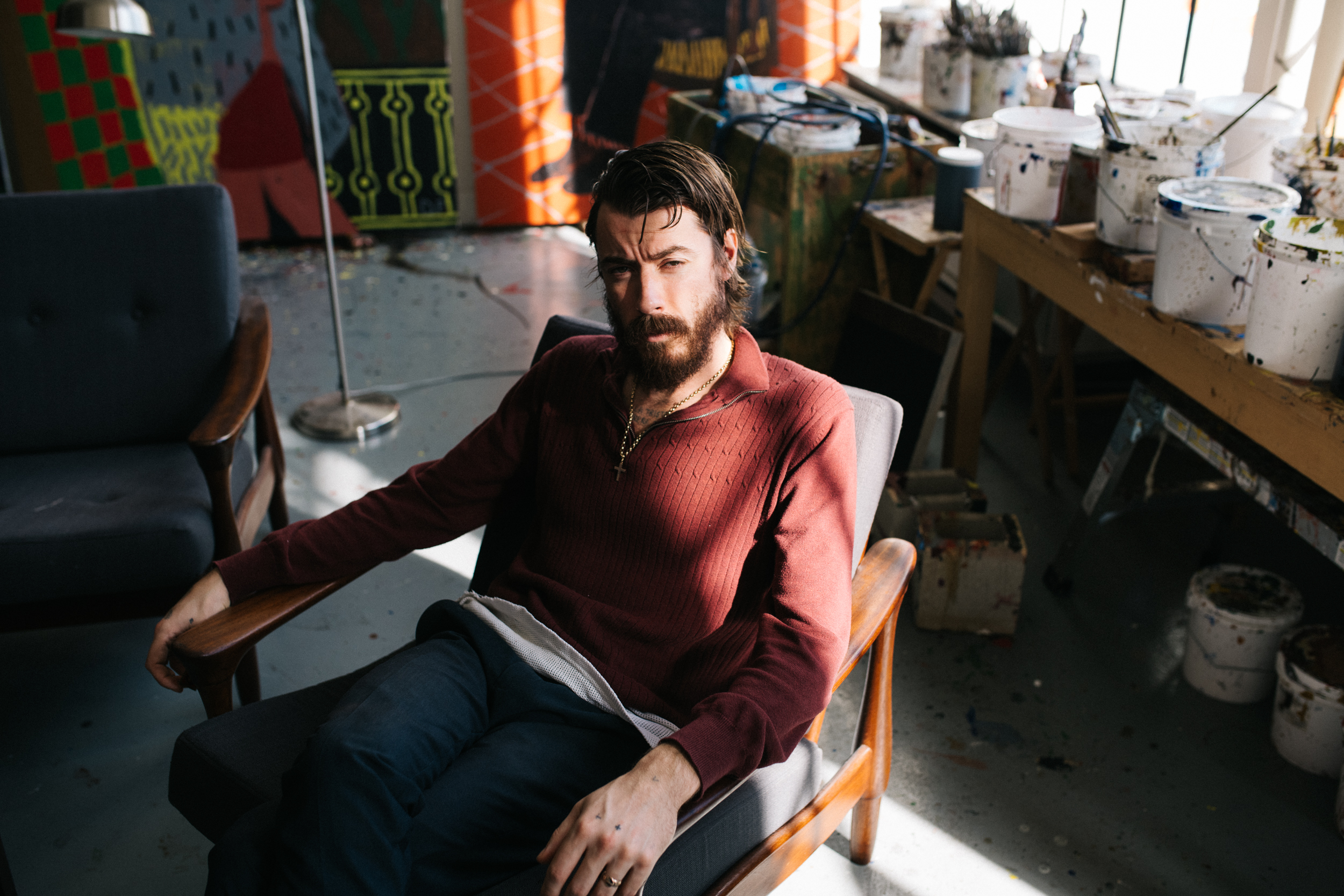
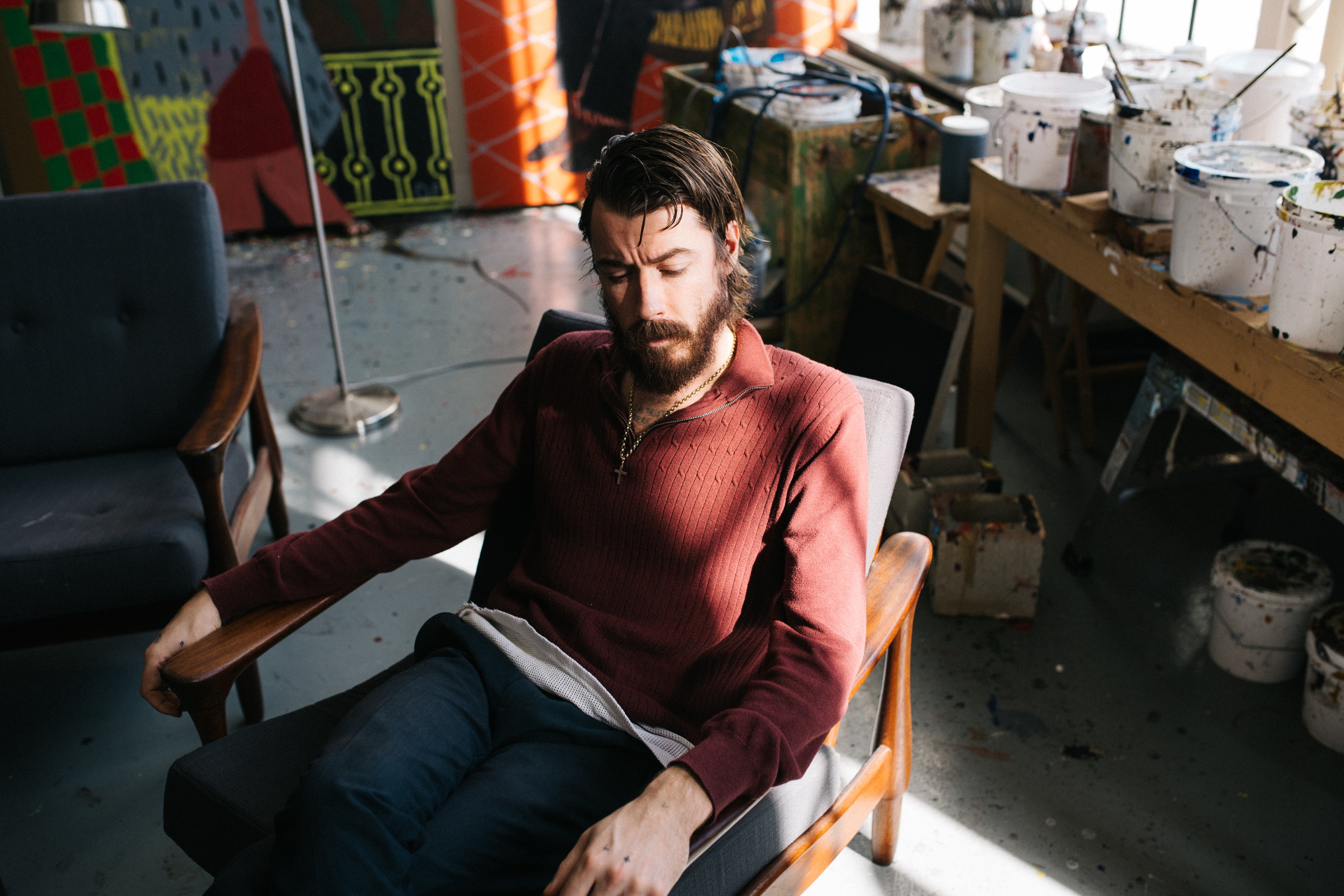
‘The pilgrims invented it. They were the first ones to break the love contract. It just led me down a road of pictures and my house was on fire, you know. My life was on fire. Last year. That’s why I put the barn on fire.’
The notion that artists can only reach great heights through suffering is a persistent myth, says Fox. His ideal conditions for painting are love, stability and sufficient sleep.
His divorce has put the act of painting into perspective as well. Fox spent a lot of time thinking about this. What has this done for him, being alone in a studio for ten years, working on his paintings? His expression is pained as he asks himself the question once again. Before he has the chance to address it, we hear a voice ring out in the hallway, a singing voice:
‘Fox. FOX. FOX. FOXXXX. I need another wall. In the middle of the road.’
An immediate change in Fox’s face:
‘That’s Henry Taylor.’
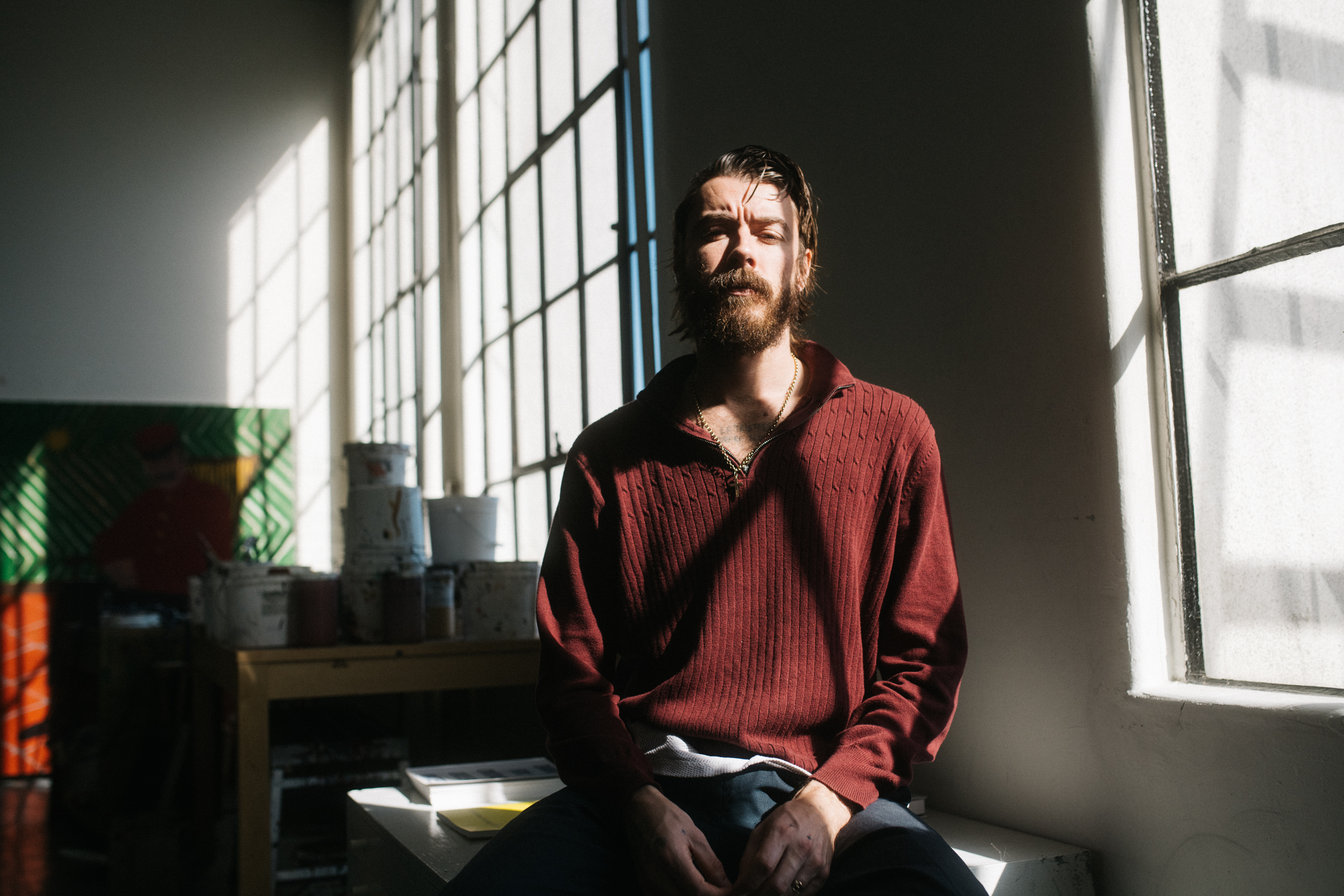
Henry Taylor?!
Side note: for more than two years I have been trying to arrange a meeting with the painter Henry Taylor, but his gallery won’t let anyone get near him, because of his busy work schedule. And here he is in the same building, singing Fox’s name. Fox asks: ‘You wanna go and say hello?’ I’m dumbfounded, but he decides for me: ‘Take the opportunity. I did. That’s how I met him,’ and he walks out to fetch him. Taylor is singing as he enters:
‘Why don’t we do it in the road. Danny said to sing for you. Cause you’re a music producer. He said Beatles songs.’
Taylor’s phrases are like lines of poetry, a clash of words, changing subjects within sentences and a hard act to follow. From the tangerines on the table to the paintings on the wall to Basquiat who, like Fox and Taylor, saw no need to work with oil paint, then to the Beatles—all in an uninterrupted flow of words that he alternately whispers, sings or shouts. When he gets up to leave I gather my courage and ask him for an interview. ‘Call me next week,’ he says. After he has left, Fox glances at me.
‘That’s Henry Taylor. 24/7.’
Four years ago, Fox sat in a London bar. Next to him someone was smoking a cigar. He had paint on his trousers. Fox knew Henry Taylor’s paintings but knew nothing about the man himself. Then it dawned on him that this just might be Henry Taylor. They started talking and he had guessed right. Taylor was in London for a show. The weeks after, Fox assisted Taylor with the preparations, they became friends. Taylor told him, ‘If you’re ever in L.A., come see me.’ Six months later that was exactly what Fox did—and here he has stayed ever since.
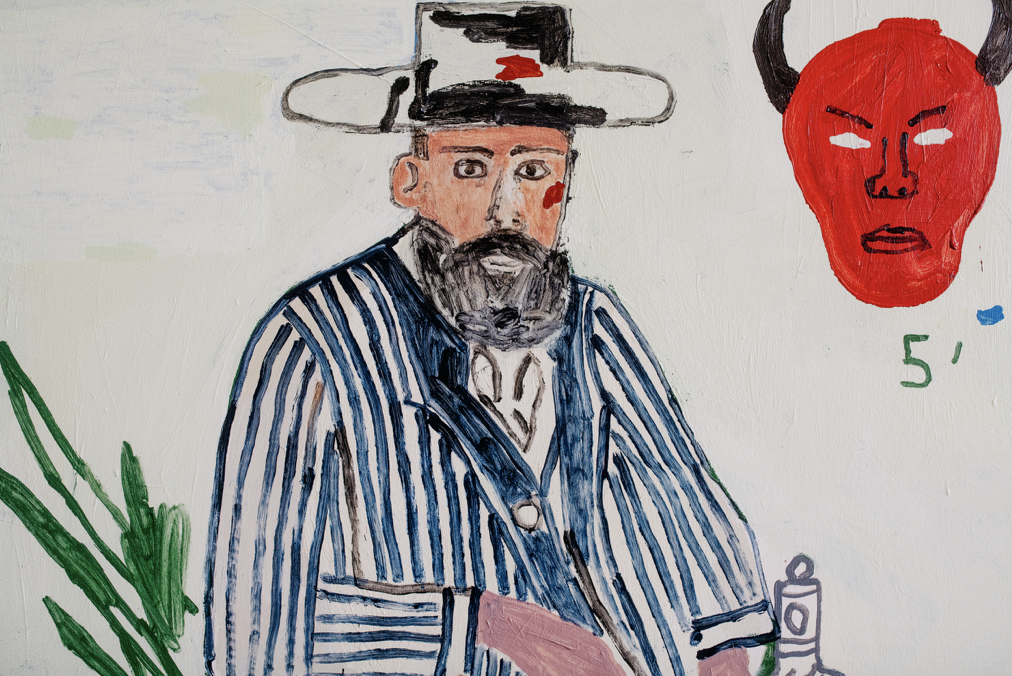
‘I came to search for Henry Taylor in the way that Bob Dylan went to look for Woody Guthrie. Or Bukowski looked for John Fante. I wanted to go work by him, find him, talk to him, before it was too late. They found their men in iron hospital beds, blind and near death. When I found Henry he was still in pretty good shape. You get yourself your conversation. You can’t just sit around and wait for the world to come for you. That’s what I’ve always known, if I want to be in the conversation with Henry Taylor, I need to find him, even if I have to cross the world.
‘This is the thing about Henry. I showed up at his doorstep. He could have said: Hi man, let’s have a beer. Nice to meet you. Goodbye. He said, come in, stay with me. He allowed that situation to happen. He was very generous and kind, for no reason. For most people a beer would have been enough.’
A week later I call Henry Taylor. It’s the first sunny day after several days of rainy weather, which is very exceptional in L.A. Shouting against the wind, he answers his phone, in the background I seem to hear the ocean roaring. He’s driving around near Venice Beach and doesn’t answer when I ask if he’ll be at the studio that day. ‘Call me tomorrow,’ he tells me. The next day he’s driving around the city again, and again he won’t be in his studio today.
Final day of my visit to L.A. I’ve arranged to meet Fox one more time for a few last questions. I walk into a space that bears little resemblance to the studio I visited before. All the paintings have been moved to his gallery, and Fox appears lost in the empty space. ‘That’s the fate of the artist,’ he says. You build something, the gallery picks it up, the paintings are sold and scattered across the world, some of them never to be seen again, and in the studio the only remaining trace of the paintings is the paint spilled at the edges onto the wall.
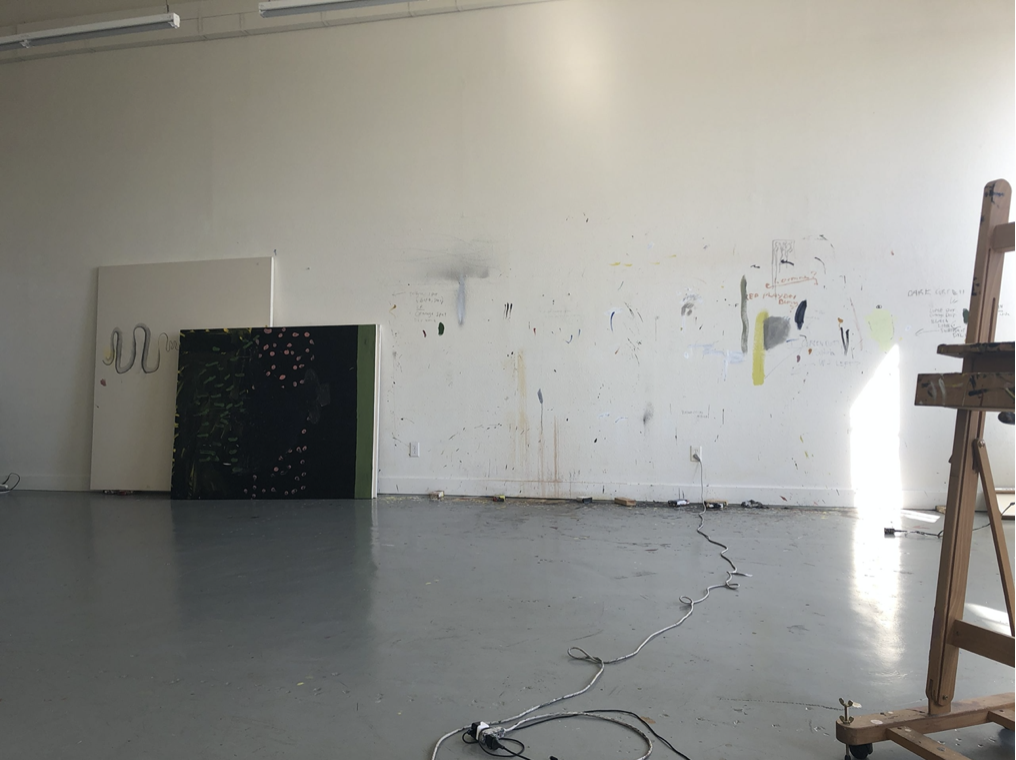
Fox has set a small canvas upon an easel in the middle of the space. Within minutes I witness the appearance of a structure reminiscent of a Japanese temple. He started reconstructing his own world again.
On my way out I try Henry Taylor one last time. He answers from his car once again. But this time he asks me to wait outside. ‘I’ll pick you up.’
A white SUV halts in front of the studio, in the middle of the road, the door on the passenger’s side is flung open. A cigarette in the corner of his mouth, ash spilled on shirt and trousers, with one hand on the wheel while the other fumbles with the car radio, and a cap on his head, Taylor looks at me with a grin. The Beasts of No Nation soundtrack blasts from the speakers. He clings to the steering wheel, as if he has become part of the car, rushing through the streets.
‘You should wear this.’
Puts a cap on my head.
‘Now you’re Taylor-made.’
‘I figured you really want this. I just want to make a piece of painting, like you want to make this article. So go ahead. This was apropos. You ain’t scared.’
As the youngest of eight (‘I was totally shut up as a kid’), Taylor paid attention to different things than his brothers. While washing his mother’s back she would tell him stories about their family and their community that his brothers didn’t know about. He absorbed it all and became an empathetic child.
Given that background it’s no surprise that he started his career as a psychiatric nurse. He liked people, enjoyed listening to them and was able to see the human being beyond the diagnosis. Patients adored him. In those days, painting was a thing he hid in his spare time. On night-shifts he sometimes painted portraits of his patients.
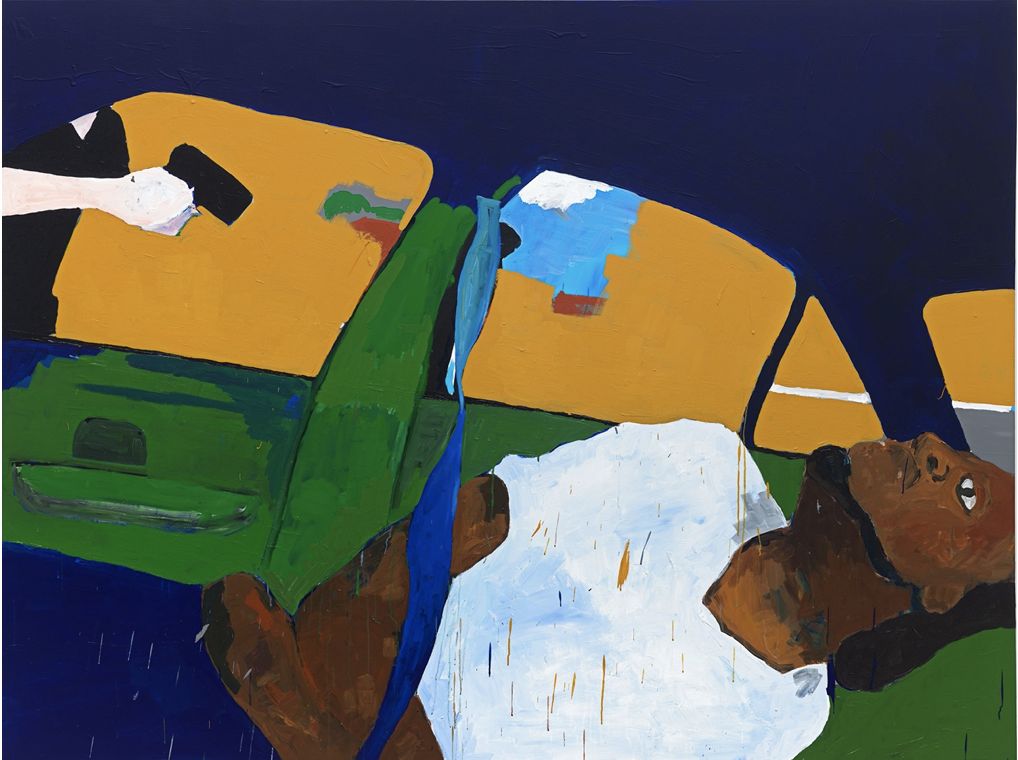
Like Fox, Taylor followed an exceptional path to art. He studied journalism, had an interest in interior design, even briefly considered fashion, and then became a male nurse. James Jarvaise was his part-time teacher. A painter who once had a show together with Rauschenberg, but Taylor was then unaware of his teacher’s prominence. It was Jarvaise who encouraged Taylor, then thirty years old, to seriously pursue painting and try his luck at art college. Taylor did not hesitate to enlist at the California Institute of the Arts. At thirty, he was a student once again. He was forty when his work began to gain attention, and now at 61, he is an important voice in the art world.
‘Sometimes you just decide what you want to do in life. At any cost, no matter what, you just do it. Going to art school meant you believed in it. In 1994 I had my last day in the hospital, when O.J. was on the freeway. After that I still had a year at CalArts, but I made up my mind: this is it.’
I ask him what art school added to the painting lessons of Jarvaise.
‘It taught me I didn’t just have to rely on painting, for example. It gave me a larger repertoire. Painting might have been just a tank. And now I have machineguns and other things that I could do. That’s part of growth. You can look back and say, maybe it expedited a more open mind. Maybe I would have gotten that anyhow. It put me in touch with certain people. I lived outside of L.A. Basquiat would have been nothing in Oklahoma or Nebraska, you know what I mean.’
Taylor grew up in Oxnard, in a community where it was the rule to look out for each other. His uncle ran a homeless’ shelter, so at an early age he became aware of people who’d had more than their share of bad luck, like those now seeking refuge on Skid Row. It taught him that the only people to fear were the police. In his paintings, Taylor combines his interest in and empathy for other people with a personal vision.
But empathy has its down-side too. An exclusive concern for the interests of others can be self-effacing. Was painting his way of paying attention to his inner self, without forsaking an empathetic point of view?
‘Yeah. What you’re saying is like sometimes I use that empathy. You bring it in. Lately I’ve been thinking a lot about Zadie Smith. How she describes people. I’m like WOW. Sometimes people really pay attention to details, gestures, how somebody is drinking their coffee. I don’t go that far because I don’t use words. But it’s about the attention. Reading her is making me look deeper. She creates this thing, like DAMN.’
Zadie Smith wrote about nuances perceived in Taylor’s work in an essay for The New Yorker. In her view, Taylor doesn’t get caught up in the narrative of ‘the black man who became a master’, because of his awareness that even for successful black people, there’s always the other story. A reality where status will not protect you from racism. In his world, success and struggle appear side by side, become interchangeable even.
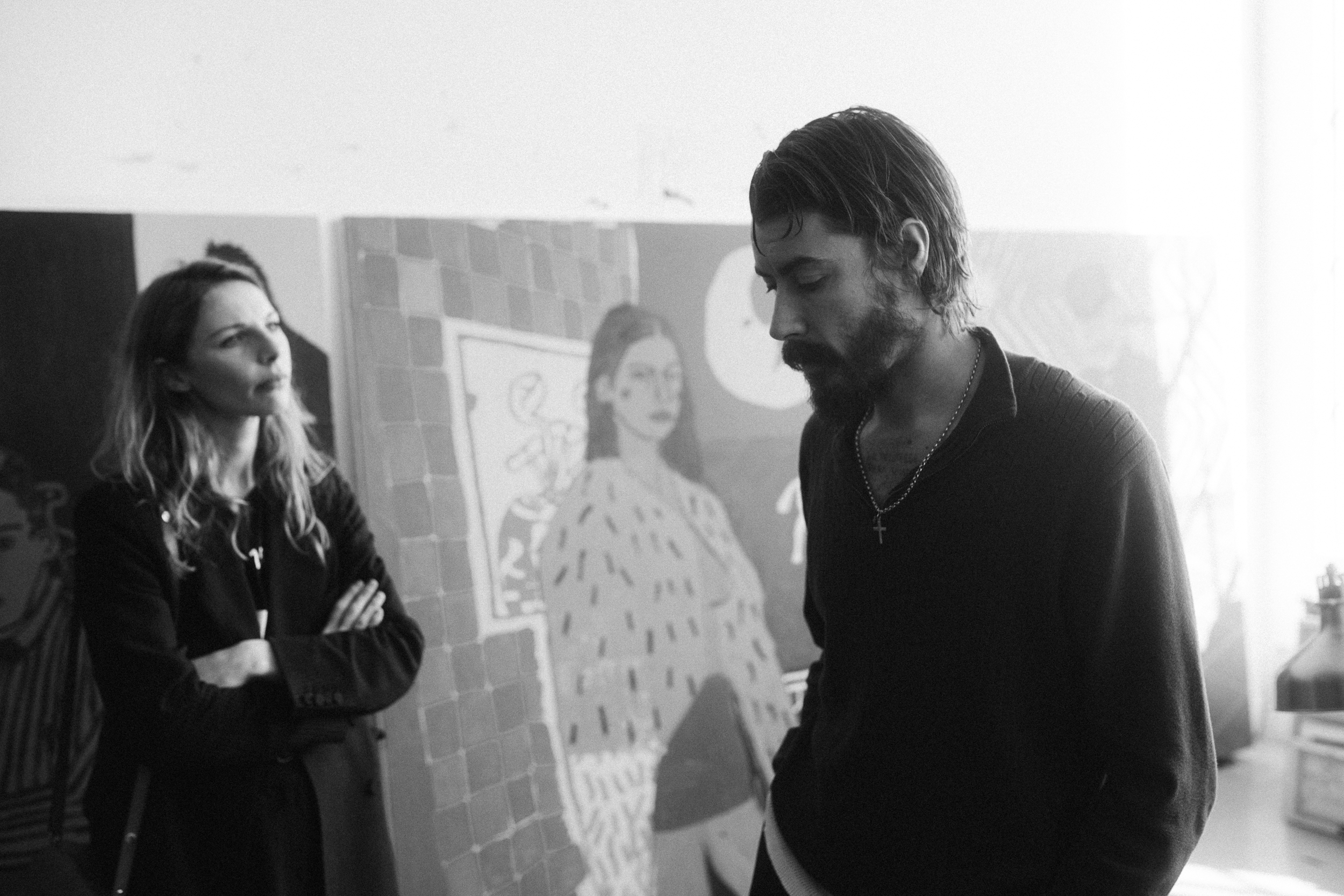
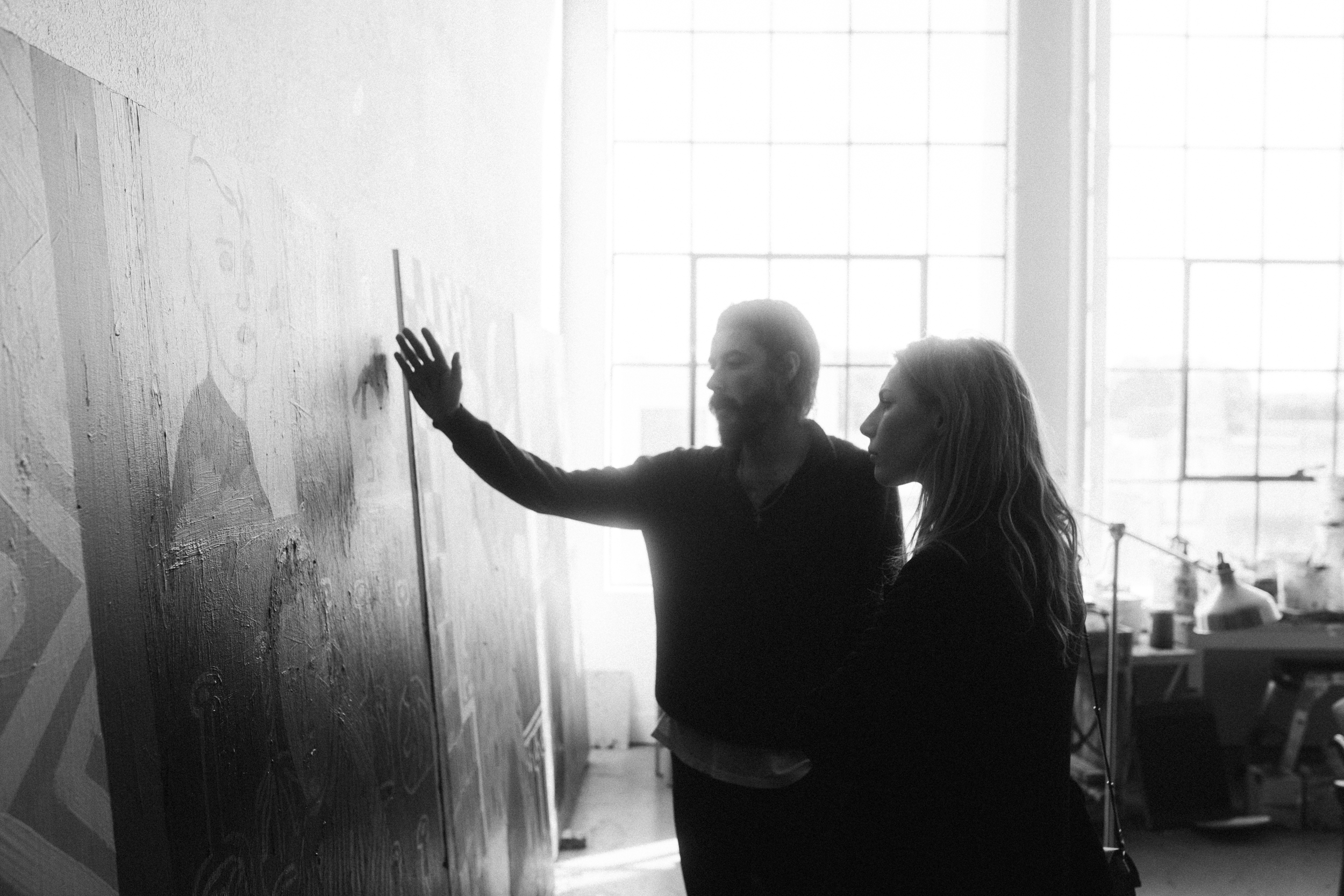
Just as Taylor misses a red light he spots a police patrol car in the rearview mirror. Its siren sounds. His face tenses, he steps on the gas. At the next traffic lights he makes a quick maneuver past the line of cars, speeding down a side street, around the next corner. We stop at a building that looks abandoned. Three Chinese characters adorn the shop-front. Deep sigh. ‘We’re now in Chinatown. A lot of galleries had this neighborhood as a beginning.’ This is Taylor’s former gallery, where he has another show forthcoming. He gets out of the car. ‘Come on.’ He points out a building down the street, informing me that Skrillex lives there.
On our way through the door, he starts rapping in a high-pitched voice:
‘Nether-Nether-Netherlands, I’m from the Netherlands. I know Michael Jackson and I know how to do the Moonwalk.’
As he looks at me sideways:
‘Taylor what are you talking about?’
Henry Taylor is full on. When he enters a room, everything and everyone in it gets swept up and set awhirl in his wake.
We walk into a space where an artist is at work. We’re here because Taylor wants to ask Sean Cassidy to make some sculptures, to be included in Taylor’s show at Blum and Poe, his gallery.
‘Damn, you got a lot of shit over here.’
This is my brother.
Rrrrrrrobin. This is Sean.
Sean, this is Robin.
I don’t know who she works for. I think she works for a hus…. I will get in trouble if I say you work for a hustler.’
‘I gotta finish this painting right here.’
He shows us a picture of a half-finished painting, due to be shipped to the Venice Biennal within a fortnight.
‘I saw this Rauschenberg show, I fucking put all these together. They picked some shit out. They picked this one, I ain’t crazy about it.’
‘I kidnapped this girl. I met her at Danny Fox.’
He walks around the studio, picking things up to take a closer look at them as he continues talking. It’s as if Taylor’s thoughts are expressed unfiltered. He tells about a place where a recent exhibition of his paintings was held:
‘The fucking roof was leaking like a motherfucker and all the motherfucking shit was coming down. Water was rolling everywhere.’
With a sweeping gesture of his arms, as if something’s coming down,
‘I feel like I’m in a church’
and he sings in a gospel voice:
‘Water was roooolling everywhere.’
Then he turns to Sean once again, who-has-to-do-the-sculptures.
‘Sean, if we just make something, it just doesn’t matter. You know what I mean.’
‘Robin, this is my ace, my dog. I’m trying to get him in my team. I don’t want to interrupt anyone’s flow. I’m trying to get a balance you know. I don’t need to work that hard now.’ To Sean: ‘Maybe I want to go to The Netherlands.’
As we leave, he tells me:
‘Sean Cassidy, remember that name.’
In the car again, Taylor leans back in his seat.
‘Shit, take a deep breath. You probably go to yoga, don’t you? You’re a yoga girl. I noticed how you breathe.’
On the way back to his studio, we drive past Skid Row. A few heads peek out from under pieces of tarpaulin. Taylor opens his window and says hi to some, waves at others. Some of them he knows from his days as a psychiatric nurse. Others he once invited to his studio, where he did portraits of them.
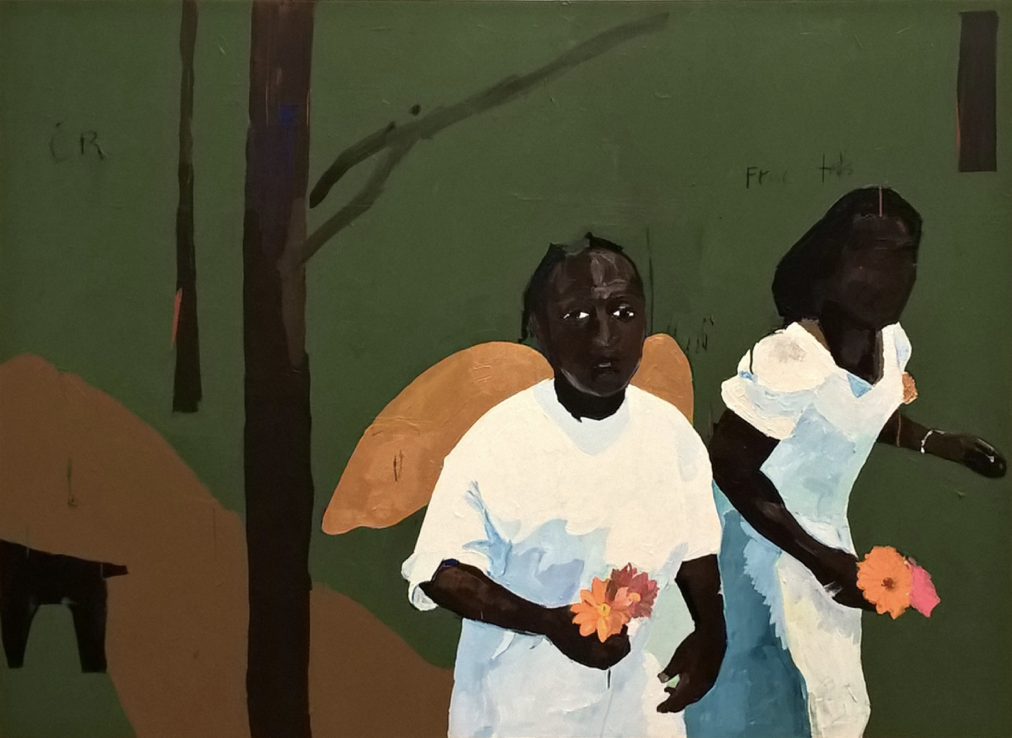
I ask him if pressure ever gets in the way of his pleasure in painting. ‘Painting portraits is something that’s always really exciting. Today when I start yours..’ He laughs.
‘I’m always looking. That goes hand in hand. It makes me more and more alive, because I’m studying all the time. Sometimes it’s just about colors. I look at everything. The trees. Sometimes I got a tree in my painting.’
He pulls up in front of the studio building, where he picked me up earlier.
‘I need to do some work now.’ He still hasn’t done any painting today and Venice is waiting. Then he asks: ‘You want a beer? I’m just catching my breath. Are you okay? You leave tomorrow? Do you want half of my sandwich?’
Taylor deftly handles the pressure he’s under. Despite the work that awaits him, he invites me up to see the studio.
We walk past Danny Fox’s place. Taylor’s studio is two doors down the hall. Even larger than Fox’s, it’s divided into two spaces. Large canvases everywhere—some merely primed, others featuring half-finished figures. Taylor introduces me to his assistant, Xeno, and starts instructing him.
‘Xeno, I will use all this paint up. Cleaning this one.’ Pokes a bit in some thick layers of dried acrylic paint. ‘Get rid of all of this.’ Takes a thick brush to smear black paint on an empty part of the canvas, where an arm is intended to be.
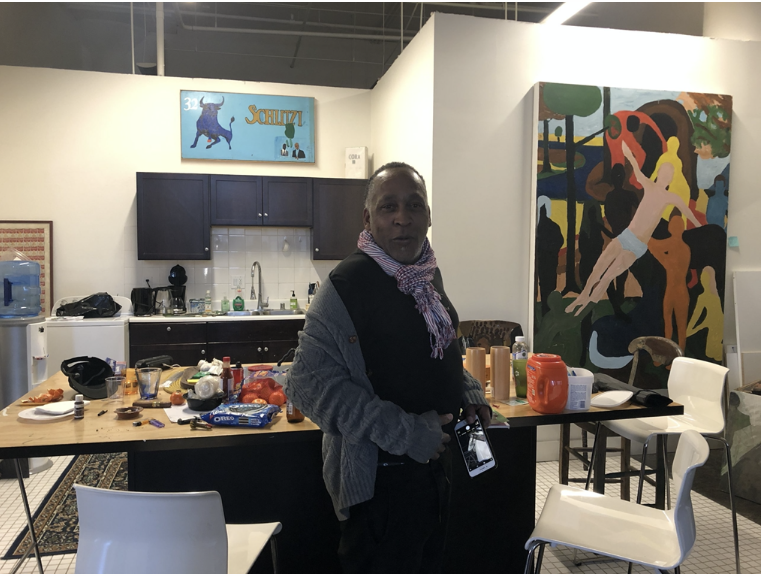
To Xeno again:
‘We’ll do this cleaning shit later. At some point we should pick a colour for this grey and this white here. This should be all orange. Sometimes you just wanna see it build up. That’s the advantage of picking this frame.. Or.. yeah.. You know what. Let’s do a warm colour. Maybe just do this: Take your time. And. Make. A. Fucking. Palette. So we both can use it, and we don’t have to do it all at once. That’s the hardest part for me, making time. Just get everything off of these two. You know what I mean. Sometimes they put shit over it. I’ll just use these things up. You know what I mean. Just do big blocks. You know. Just a big fucking block. And use a warm colour for that. Orrrr…’ Then he turns to me: ‘I’m sorry, are you okay?’ Continues his instructions a bit longer, which Xeno receives impassively. ‘We’ll just block this up.’
After some more gesturing at the painting, he sets himself at the little bar.
‘You want a beer?’
We talk some more about the painting process. Taylor doesn’t spend too much time thinking about his canvases.
‘I just hunt and gather. Sometimes I just get lucky. The process changes. When there’s a demand you don’t have time to think and play as much.’
‘I work more than one way, I work abroad. If you’ve got time to play, you play. If you’re in a hurry and someone’s coming for dinner, you just scramble an egg. Sometimes you make pancakes, it all depends on the time you have. You have to adapt.’
Taylor then lets me know he really needs to get some work done. I tell him I’ll find my way out. He asks me where I’m going. I’m heading for a coffee shop close by.
‘I’ll bring you there.’
And before I know it we’re back in his car. Speeding through the city, we’re staying ahead of time.


